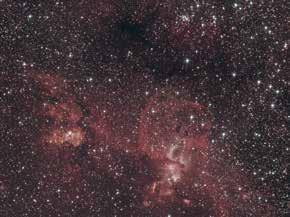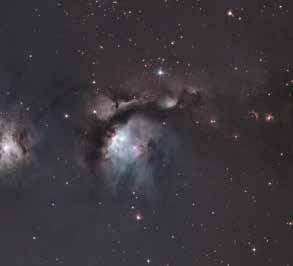
2 minute read
The Skies Above Bribie
The Skies Above
Bribie By: John Stevenson
Advertisement
With the abundance of cloud and wet weather throughout January, I for one welcomed seeing sunshine on the odd occasion throughout the month. Let's hope February will provide us with more clear and warm nights where we can continue to explore the constellations. Before we move on, I often get asked: “What is a suitable first telescope, once we decide to explore the night sky in closer detail?” The most important part of a telescope is its mounting. This provides stability for the optics, and a poor or unstable mount will lead to vibration and ultimately frustration. There are 2 basic types of mount, Alt-Azimuth or Equatorial. Generally, Alt-Az mounts are for terrestrial viewing and Equatorial mounts are for astronomical use. The advantage of an Equatorial mount is it only uses one axis to follow or track an object, however, they do take longer to set up and must be aligned parallel to the earth’s rotational axis. It can be a steep learning curve, but once understood can provide hours of enjoyment and navigation skills later in life. In my case, these skills lead me to a career in cartography and mapping. Moving on to the February sky, Sirius the brightest star in the night sky is high overhead. The constellation of Gemini, with stars Castor and Pollux, is to the northeast. The southern constellations of Puppis, Carinae and the most familiar of all the Southern Cross with pointers, (Alpha Centauri and Hadar), just rising. This rich section of the Milky Way, climbing higher through the night, contains some fascinating objects viewed with binoculars. Our object of the month is The Carinae Nebula. The largest diffuse nebula in our sky and also the brightest. It contains the prominent variable star, Eta Carina. This star has varied in brightness dramatically within the last 200 years. At one stage in 1837 became one of the brightest stars in the sky until fading to near-invisible in 1856. It has been increasing in brightness again since 1940. One of the local astrophotographers, Katherine Miller, has contributed 3 stunning images taken last week. Including the Carinae Nebula and The Statue of Liberty Nebula, both located in this area of the Milky Way and visible with binoculars. Her third image is a reflection nebula M 78 in Orion. It is only visible from the earth by the reflected light of the 2 brighter stars. Thank you, Katherine, for sharing your images. In regards to planets in our sky, Jupiter and Saturn are moving towards being morning objects, with Mars still visible in the Northwest. Interestingly, on Feb 18th the world will be watching and holding its breath as the Mars rover mission, “Perseverance” is scheduled to arrive on Mars with a soft landing. Only 50% of Martian landing attempts, by any space agency, have been successful. After such a long journey, the rover will spend 2 years exploring the once water-filled Jezero Crater, on the Martian surface, collecting rock samples and returning them to earth in 2031. Stay safe Bribie, and have fun exploring the night sky with friends and family. Always ready to answer questions by email, and please note the new email address: bribie.astronomer@gmail.com
John Stevenson Owner/Operator of Banksia Observatory

M 78 Katherine Miller Statue of Liberty Nebula Katherine Miller









